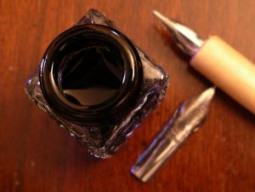
“Every word I draw speaks to me. Every word complains about what I’ve done with it,” the soft-spoken man tells The Express Tribune while sitting in a small wooden cabin in the bustling office of the Ummat, one of the country’s largely circulated national dailies.
Sporting a smartly trimmed grey beard and clad in crisp traditional shalwar kameez of the same colour, Shahid looks like an average man until he starts opening up. It all depends on his mood – his advanced age and falling health have made him a little cranky.
He belongs to the tiny Kalyani community, named after Sufi saint Hazrat Kelian Wala, who dwell in the small town of Ali Pur Chathha in Punjab.
The community specialises in the art of Arabic calligraphy it has preserved and passed on for generations. They have mostly printed copies of the Holy Quran.
Immersion in art
Shahid started learning the family business from his grandfather at the age of 12 and landed in the newsroom of an Urdu-language daily, the Wafaq, as a katib in late 1957 in Lahore.
For decades, books, novels, handbills, magazines and newspapers had been written by katibs – as they are known – until the printing press made its way to the Indian Subcontinent years after Partition. Prior to the introduction of the printing presses, thousands of katibs would be hired and were able to earn a decent livelihood for their families.
For a katib working for a newspaper, Shahid says it was a must to write in the main styles – Nasta’liq, Nasakh, Sulas, Riqqa, Koofi and Hur.
“Khat-e-Nasta’liq is very ruthless, I tell you honestly,” he explains pointing his finger at the headlines on the newspaper’s front page written in the Nastai’liq style. It differs from the headlines of news features on the colour pages.
“It’s the most difficult to learn, even after years. It complains when I make a minor mistake. At times the words even bash the writers,” admits the calligrapher whose career has spanned over 57 years.
For the last two decades, Shahid has drawn the headlines of the Ummat newspaper and its famous magazines Takbeer and Ghazi in simple, attractive and fancy font.
Painting on the wall: Street artists bring works to the masses
“Initially, at the newspaper a katib was assigned to write news stories, then second headlines (or shoulders as is called in Urdu journalism) and finally the headlines,” he explains.
As computers made their way to developing Asian countries, writing software was also developed to compose in Urdu and the media industry saw computers replacing traditional writers.
In his hay days, Shahid drew the titles or mastheads of dozens of newspapers, news items and literary magazines.
“I don’t remember exactly how many publications’ titles I have drawn,” he says, struggling to count the number of his successes.
“What I still remember is that in those days whenever I would visit a newspaper stall anywhere in Karachi I would find, except for a few ones, that almost every issue had their titles drawn by my hands,” he said humbly, cursing himself for not having maintained records of his work.
Shahid is now among the very few calligraphers left in the newspaper industry and feels the side-effects of the information technology.
“On one hand, computers have expedited the old time-consuming process of writing books, editing them, having them bound and then sending the final editions to the market,” he recalls.
Seminar urges inclusion of calligraphy in curriculum
Today, he says, with the help of computers – the unmatched competitors of calligraphers – any publication can be prepared within a few short days and is quickly available for reading. “Take the example of textbooks’ printing and publication. It has largely helped in the promotion of education in the country,” he adds.
However, the traditional calligrapher complains that the software is developed with a variety of writing styles of Urdu, Arabic and other languages that can easily be installed in computers. “Most of these computer fonts’ look very weird,” he complains. “I don’t mind how many new fonts you introduce, but every style should be readable and look decent.”
Over the past five decades, Shahid has taught calligraphy to countless people, but says none of them could earn a name in this field.





























1713853507-0/MalalaHilary-(2)1713853507-0-270x192.webp)








COMMENTS
Comments are moderated and generally will be posted if they are on-topic and not abusive.
For more information, please see our Comments FAQ